Cures for the common cold
Professor Bordier’s cure for the common cold
Electrifying the nose to cure the common cold. The electrification would continue until "the patient finds it difficult to bear the treatment."If it worked, I would use it to get rid of a cold. But I'm pretty sure the best it did was to temporarily relieve symptoms.
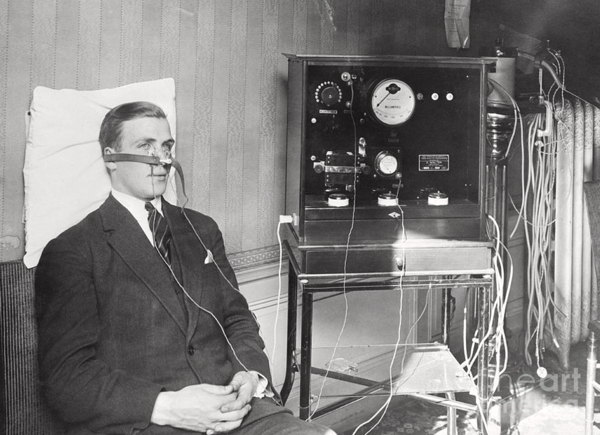
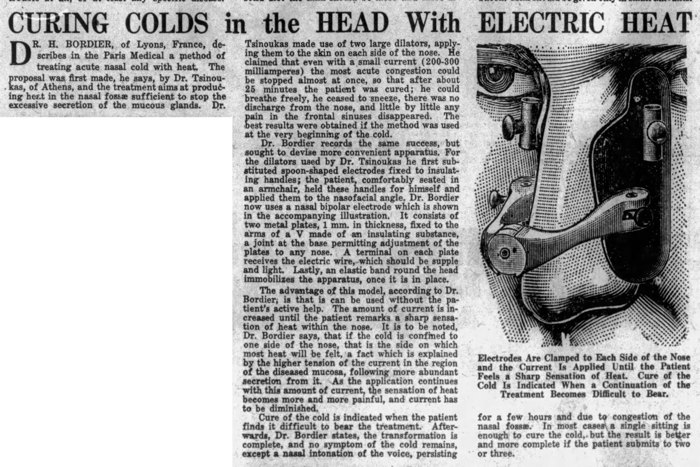
Montgomery Advertiser - Sep 11, 1927
Posted By: Alex - Mon Aug 07, 2023 -
Comments (2)
Category: Cures for the common cold, 1920s
Listerine Cigarettes
Another case of an odd brand extension. In 1927, the manufacturer of Listerine debuted Listerine Cigarettes that were infused with the same antiseptic oils used in the mouthwash.The company claimed that these cigarettes would not only "soothe the delicate membranes of mouth and throat," just like the mouthwash, but also that they would "kill 200,000,000 germs in fifteen seconds" and help smokers avoid colds.
As far as I can tell, Listerine Cigarettes remained on the market until the mid-1930s and then disappeared.
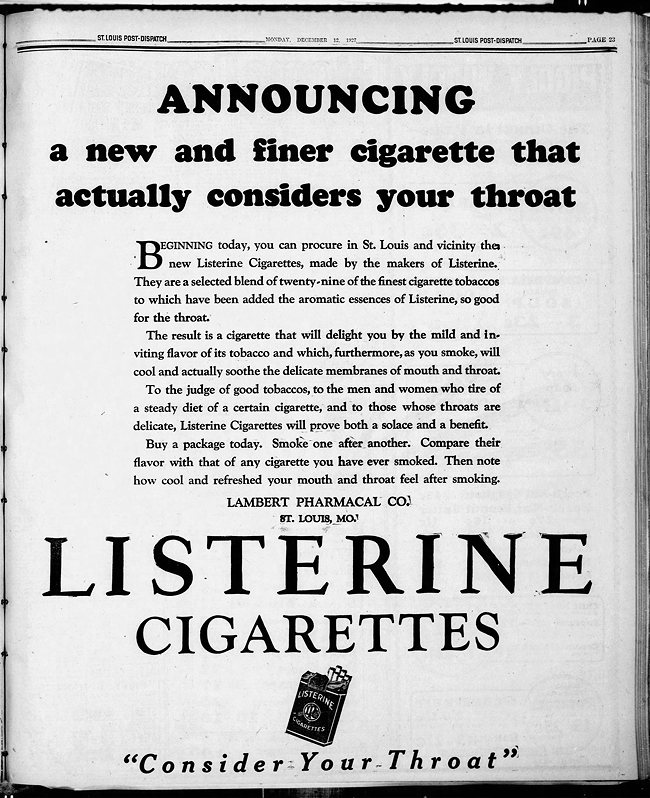
St. Louis Post-Dispatch - Dec 12, 1927
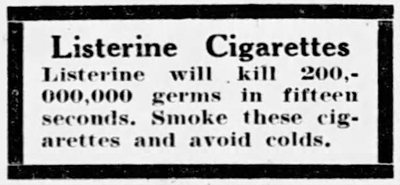
Tampa Tribune - Nov 8, 1930
Posted By: Alex - Sat Jun 19, 2021 -
Comments (5)
Category: Health, Cures for the common cold, Smoking and Tobacco
Chlorine gas cures colds
During the 1920s, chlorine gas (the same stuff used as a chemical weapon in World War I) briefly became popular as a cure for the common cold.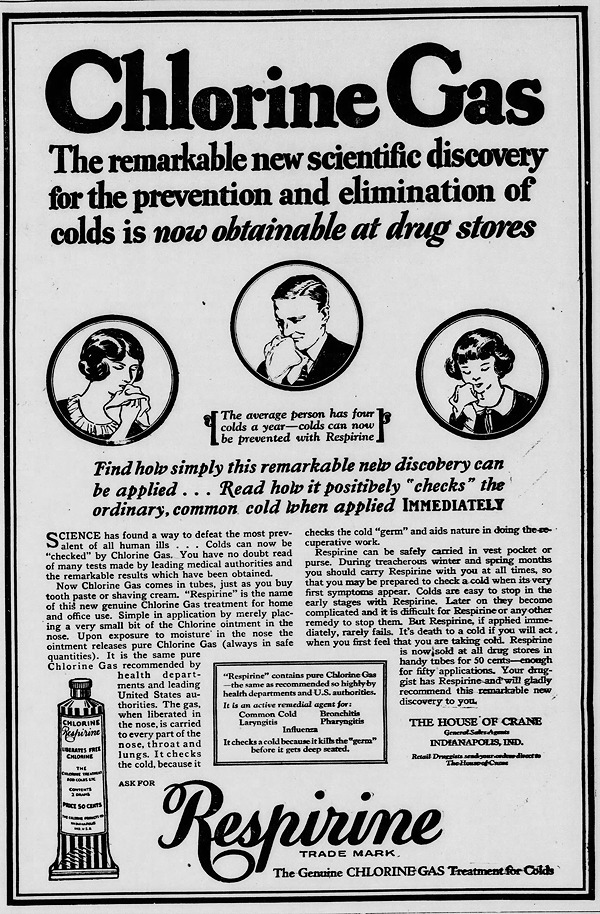
The Rushville Daily Republican - Mar 26, 1926
Jennifer Ackerman explains what was going on in her book Ah-Choo! The Uncommon Life of Your Common Cold:
Chlorine was thought to act as a kind of thorn-in-the-flesh therapy. Vedder (dubbed "the chemical warrior" by Time magazine) proposed that "the irritant action of chlorine stimulates the flow of secretion and cleanses the mucous surfaces," resulting in "productive coughing and blowing of the nose." Through its oxidizing action, the gas was also thought to rid the body of toxins and fuel the activity of white blood cells useful in the attack against offending microbes.
Practically overnight, chlorine therapy became a popular treatment for victims of colds, bronchitis, and whooping cough... For the general public, there was Chlorine Respirine, 50 treatments for $0.50 in a handy collapsible tube, each dose purported to "knock a cold in three hours."
Controlled experiments eventually debunked the idea that chlorine gas had any curative value. Though I'm not sure how to explain why people exposed to chlorine didn't seem to catch colds as often. Perhaps it was just mistaken, anecdotal evidence. Or perhaps the chlorine gas was sterilizing surfaces, helping to prevent the transmission of germs.
Posted By: Alex - Fri Nov 20, 2020 -
Comments (1)
Category: Health, Patent Medicines, Nostrums and Snake Oil, Cures for the common cold, 1920s
Canned Sunshine
The idea of using sunlight to kill viruses inside the body has recently been in the news. That made this old invention I posted about last month seem topical.Edward W. Boersteler, of Watertown, MA, was the inventor of the ‘Curay Light Applicator,’ aka ‘Canned Sunshine.’ Back in the 1920s and 30s, he marketed it as a cure for the common cold. It emitted ultraviolet light, which people were supposed to shine down their throats, killing the germs.
In the selection of text below (taken from an article in the Chilicothe Constitution Tribune - Oct 16, 1925), I didn't correct any of the misspellings. In particular, I wasn't sure whether the phrase "ultra violent light" was a mistake, or intentional.
“Fused quartz transmits ultra violent or invisible light without loss, whereas ordinary window glass shuts out ultra violent light which is the curative agent in sunshine.
“In the Curay Light aplicator,” Boerrsteler continued, “we have produced a source of radient energy closely approximating concentrated sunlight in the upper altitude, with an equivalent ultra violent content. Though it is a potent germ killer, it is harmless to the cels of the body.
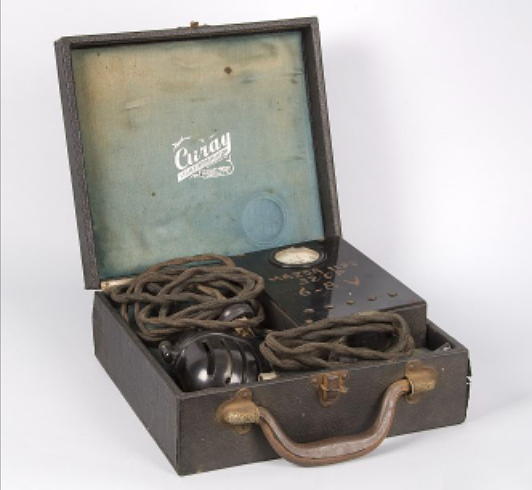
image source: Harvard University Collection of Historical Scientific Instruments
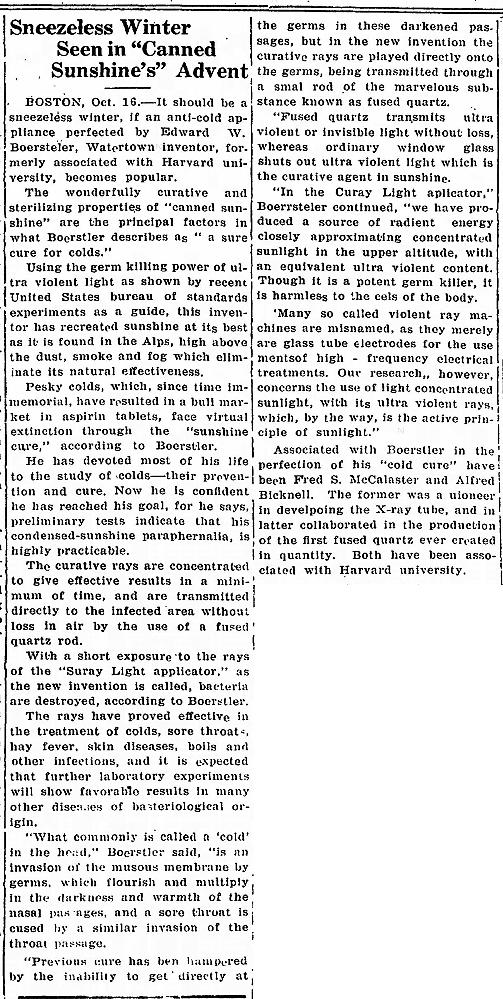
Chilicothe Constitution Tribune - Oct 16, 1925
Posted By: Alex - Fri Apr 24, 2020 -
Comments (4)
Category: Health, Inventions, Cures for the common cold, 1920s
Helmet Heat
-Wausau Daily Herald (Apr 20, 1957)
The heat might actually have helped to alleviate symptoms. So, in that sense, it wasn't a bad idea. But I doubt many people were willing to wear this for an extended period of time.
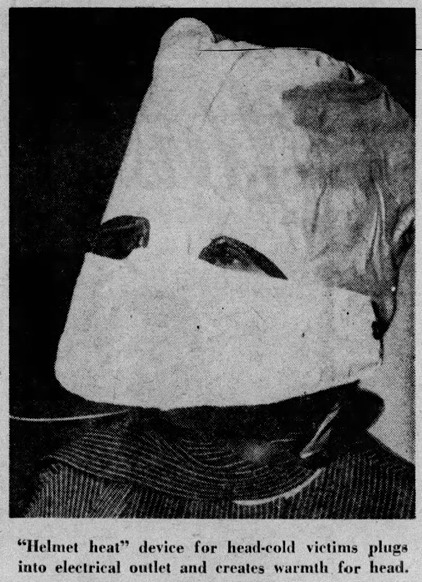
Dayton Daily News - June 16, 1957
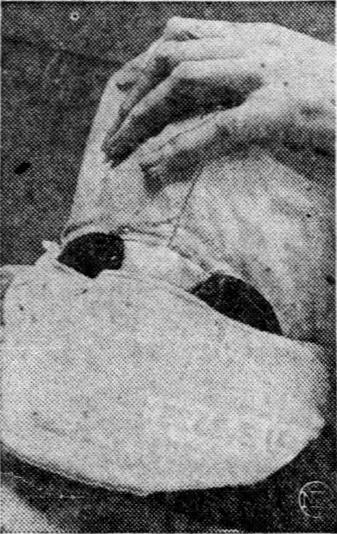
Wausau Daily Herald - Apr 20, 1957
Posted By: Alex - Thu Feb 06, 2020 -
Comments (2)
Category: Health, Cures for the common cold, 1950s
Pre-Infected Tissues
The company Vaev claims to be selling tissues that have already been sneezed into. For about $80 it seems that you get a box containing one infected tissue. The idea apparently is that you can infect yourself with a cold, and this will somehow strengthen your immune system, thereby protecting you from further colds or the flu. Although the company's website is very vague on details, offering only this:The idea is so odd that I wonder if it isn't some kind of hoax. Note that it isn't actually possible to buy these things because the company's online store claims to be sold out.
More details at Yahoo News!.
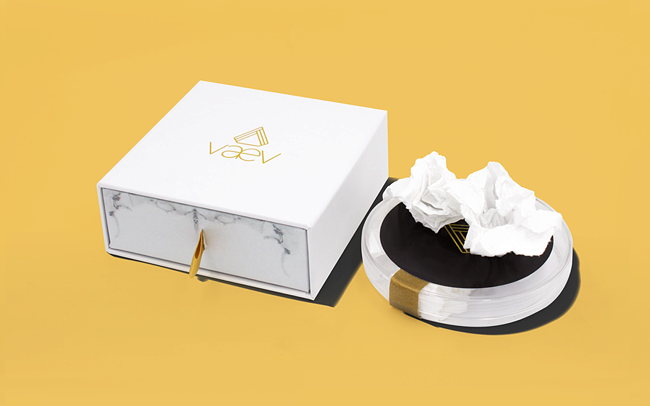
Posted By: Alex - Thu Jan 24, 2019 -
Comments (4)
Category: Health, Disease, Overpriced Merchandise, Cures for the common cold
Inductive Nasal Device
Norman Lake's cure for the common cold. Otherwise known as the "IND".More info: Chicago Tribune - Nov 20, 1985
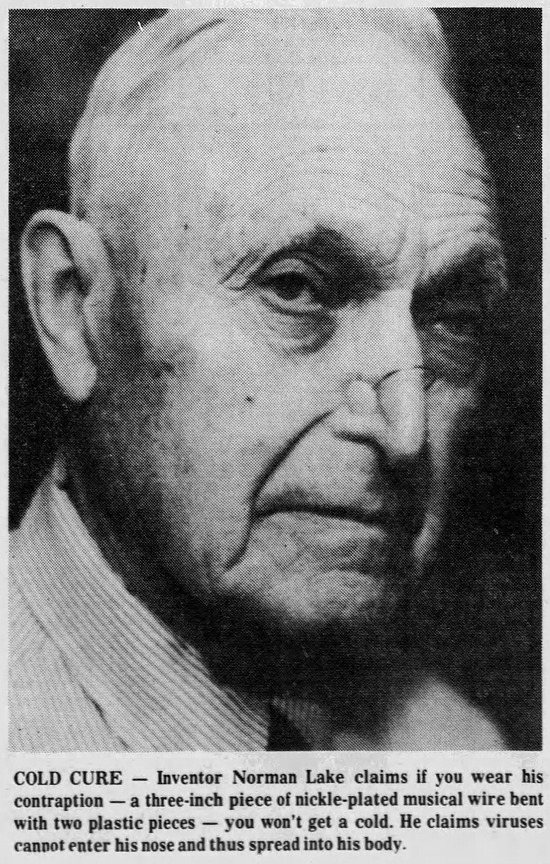
Chambersburg Public Opinion - Apr 23, 1982
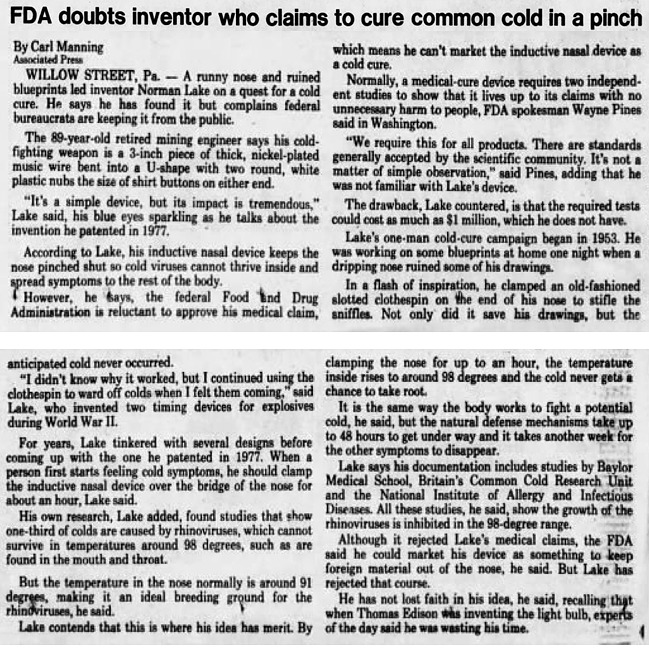
Arizona Republic - May 8, 1982
Posted By: Alex - Mon Sep 10, 2018 -
Comments (1)
Category: Health, Inventions, Cures for the common cold, 1980s
Chilling big toe cures runny nose
As reported by Israeli scientists Dr. Menahem Ram and Aladar Schwartz at a 1971 joint meeting of the Society for Cryobiology and the International Conference of Refrigeration: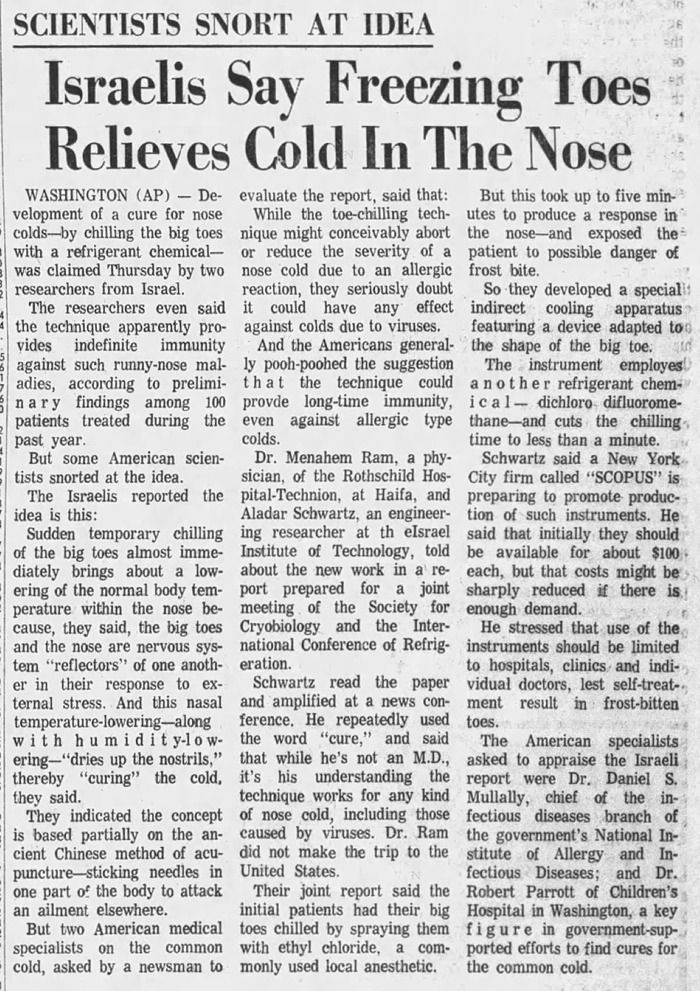
Newport News Daily Press - Sep 3, 1971
Posted By: Alex - Thu Aug 16, 2018 -
Comments (6)
Category: Mad Scientists, Evil Geniuses, Insane Villains, Medicine, Cures for the common cold, Science, 1970s, Feet
Turpo
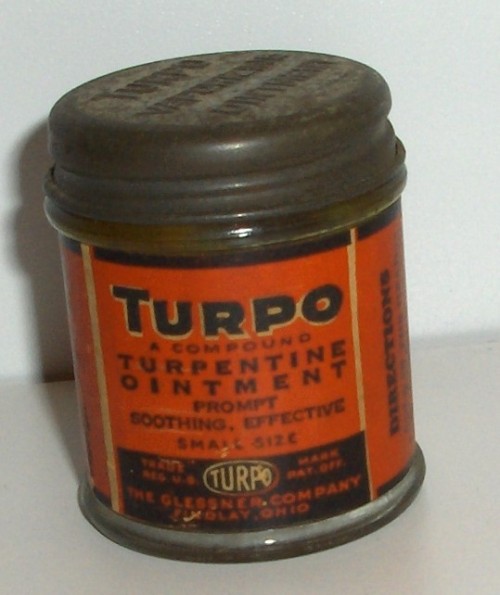
A salve made from turpentine? The same stuff you clean your paint brushes with? A wonder drug! And apparently, it cured colds, burns, and so much more!
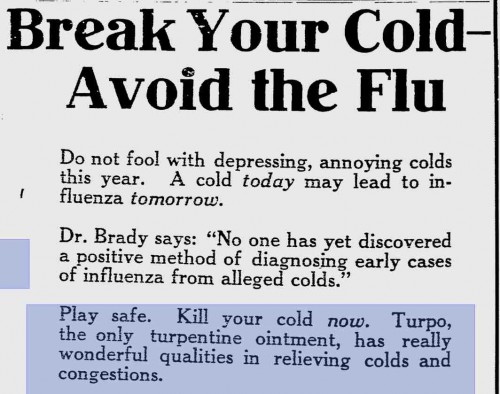
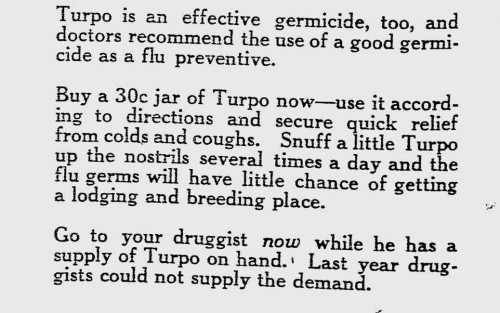
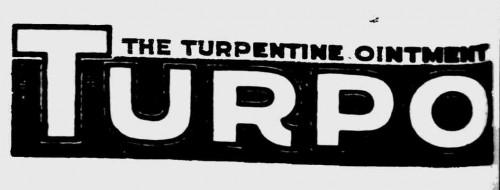
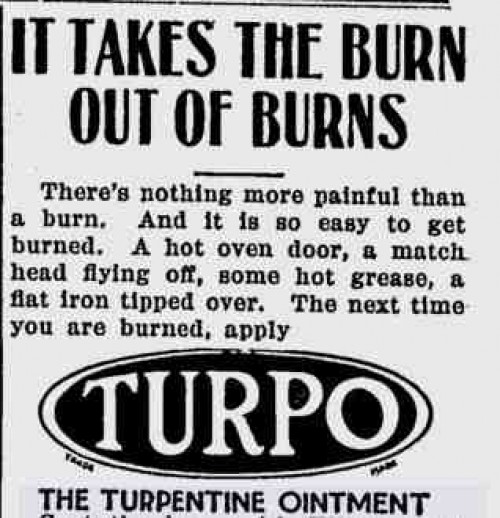
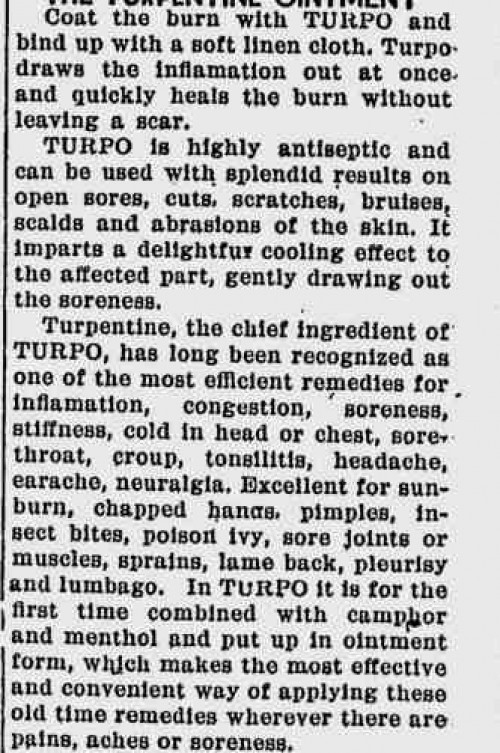
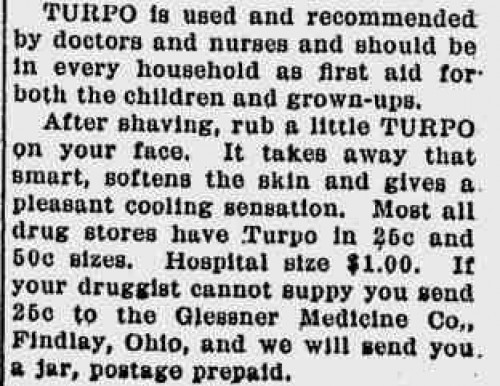
You say you wish you could get your hands on some of this miraculous stuff? The Russians still make it! Follow the Amazon links below.
Posted By: Paul - Fri Apr 20, 2012 -
Comments (15)
Category: Health, Hygiene, Medicine, Cures for the common cold, 1920s, Russia, Diseases

| Who We Are |
|---|
| Alex Boese Alex is the creator and curator of the Museum of Hoaxes. He's also the author of various weird, non-fiction, science-themed books such as Elephants on Acid and Psychedelic Apes. Paul Di Filippo Paul has been paid to put weird ideas into fictional form for over thirty years, in his career as a noted science fiction writer. He has recently begun blogging on many curious topics with three fellow writers at The Inferior 4+1. Contact Us |




